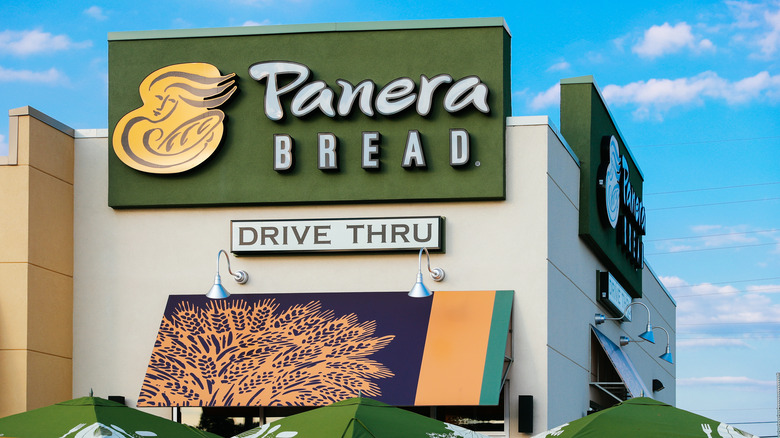How Panera Helped Inspire Free Restaurant Wi-Fi
Some of the restaurant industry's most genius inventions seem like they've been around forever. But when it comes to a lot of the most common incentives for eating out, many come from innovative chains that are still alive and well today. For example, CNBC informs us that we have the fast food chain Wendy's to thank for popularizing the concept of the drive-thru. And when it comes to fast food's existence in the first place, White Castle was the first such establishment to open in America in only 1921, according to Smithsonian Magazine. But that's just the tip of the iceberg. Let's consider a more recent phenomenon.
Those who frequent their local Panera Bread might be fans of the eatery for its soft sourdough bread bowls or the steady stream of fresh, hearty soups. Looking at another chapter of its history, however, you might start to love the bakery-cafe chain for a little bit more than that: If you've ever ventured out of your home or office to get some work done at a coffee shop or bistro, you probably have Panera Bread to thank for that luxury.
How Panera Bread changed the restaurant industry
So, how did Panera Bread of all places become a pioneer in Wi-Fi accessibility? The story goes all the way back to its original mission. According to Panera Bread's website, the chain opened its doors for the first time in 1987 under its first title St. Louis Bread Company (it wasn't called Panera Bread until the late 1990s). The now-familiar spot was an unassuming neighborhood bakery at the time with a small focus on its sourdough offerings — you probably wouldn't recognize the menu if you saw it today!
Upon growing the business a few years later, founder Ron Shaich (who first launched Au Bon Pain and acquired St. Louis Bread Company in the 1990s, per Panera) began to realize that what his customers actually wanted was not just tasty baked goods, but a gracious and inviting atmosphere. This realization became his mission.
As Panera Bread eased into the 2000s, the company recalls that it "invested in the customer experience — things like design and WiFi, which encouraged guests to linger — and turned Panera into a gathering place." The ideas worked and the cafes began to thrive, even helping to spur the creation of more "fast casual" chains. Soon Panera had grown immensely and would soon offer almost 1,500 homes away from home around the nation. Then, the company decided to introduce a revolutionary concept: free Wi-Fi in its cafes.
The age of free cafe Wi-Fi
In a bid to boost sales amid the low-carb diet era, the SEC reveals that Panera Bread became the "largest provider of free Wi-Fi access" in America in 2004, adding the special bonus to at least 600 of its locations. Back then, customers traditionally had to pay for Wi-Fi access, but Panera Bread's decision to make it free signaled a big change in the years to come. The idea was so successful that ABC News reported a boost in Panera Bread sales by 15% soon after it was implemented — and word of the sensation spread so far in the following years that the network was almost overloaded in 2012, with nearly 2.7 million Panera customers connecting each month.
After seeing the success Panera Bread experienced with its free Wi-Fi, many big chains followed suit: The New York Times reported that Starbucks and even McDonald's started to offer the service a few years after Panera. Soon, as The Guardian later noted, free Wi-Fi started to pop up everywhere. So the next time you go to a local cafe or restaurant to get some work done, think about how Panera Bread took a leap for all of us first.


